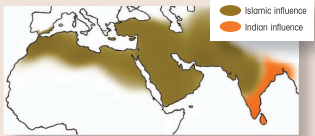The earliest usage of henna is believed to have originated in Africa during the last ice age, approximately between 7500 and 3500 BCE.
The Evolution of henna
This period saw the Sahara region greener than its present state. According to a theory, humans herded livestock across the warm savannahs, and some of the animals grazed on henna plants, resulting in their mouths being stained with a red-orange hue from chewing the leaves. If the herdsman noticed these stains and grew concerned, mistaking them for blood, they would attempt to remove the chewed leaves from the animal’s mouth, consequently staining their own hands red. This discovery might have been the “Aha” moment, realizing that crushed henna leaves can stain the skin without any harmful effects.
The Evolution of Henna Book

Through continued observation, people would have learned that crushed henna leaves, when mixed with a slightly acidic liquid, could stain hair, fingernails, and skin. They also discovered that this staining property offered relief from nuisances such as head lice and fungal infections affecting the skin, nails, and hooves. This anti-fungal effect likely contributed to the cultural belief in the “baraka” or blessing associated with henna.
The geographical spread of henna was likely aided by birds. Assuming henna was native to North Africa during the last ice age, birds could have consumed the berries and dispersed the seeds through their droppings as they migrated northward and eastward along river valleys and coastlines. As the climate warmed, henna found its way into its current habitats, including the southern and eastern coasts of the Mediterranean, North Africa (from the Atlantic coast to the Red Sea), East Africa (from Egypt to Zanzibar), the Arabian Peninsula, the Persian Gulf region, Pakistan, India, and Indonesia. Henna thrives best in frost-free areas with prolonged drought periods.

There is physical evidence of early henna usage in Egypt dating back to 3400 BCE. Mummies, including that of Ramses II, showcase gray hair dyed with henna. However, there is no evidence of patterned henna body art during the Egyptian dynastic period, suggesting henna was primarily used to disguise graying hair or for therapeutic purposes at that time.
In the Bronze Age, artifacts discovered along the eastern Mediterranean coast near Syria, Cyprus, and the Aegean Islands provide insights into the origins of henna body art traditions associated with women. Between 2000 BCE and 800 BCE, statuettes of women with hand markings consistent with henna, as well as fragments of ancient texts from the city of Ugarit, indicate henna’s use in adorning women’s bodies to celebrate fertility, betrothal, sacrifice, and victory. These early connections between women and henna laid the foundation for the “Night of the Henna,” a ritualistic application of henna patterns on a bride before her wedding, still observed in henna-using cultures today.

Similar evidence of henna’s usage for body markings exists in customs related to betrothal, sacrifice, and victory in pre-monotheistic groups in Syria, Cyprus, the Arabian Peninsula, and the southern Mediterranean. These practices were prevalent in regions inhabited by cultures venerating deities such as Baal, Anat, or Tanit. The Assyrians had already incorporated henna into women’s wedding preparations by 800 BCE.
Some of these cultural applications of henna seem to have influenced early Jewish traditions from pre-monotheistic religions. Henna was indigenous to Israel during the biblical era and is affectionately mentioned as “camphire” (the Latin transliteration of “kopher,” ancient Hebrew for henna) in the Song of Solomon. The ancient Romans were familiar with henna and used it as a hair dye, although its usage for body markings was not widespread and more closely associated with the cultures of their eastern provinces.
Overall, the history of henna is deeply intertwined with various cultures and regions, evolving over time through observations, practical uses, and cultural adaptations. From its probable origins in Africa during the ice age to its spread through bird-assisted dispersion, henna has played a significant role in hair coloring, folk medicine, and skin adornment. Its versatile properties, such as staining keratin and possessing anti-fungal effects, have contributed to its enduring popularity and cultural significance across different societies.
As henna continues to be cherished and celebrated in diverse communities, its rich history and uses serve as a testament to its enduring appeal and the enduring artistry of henna.







Pingback: The History and Uses of henna - Mehndi Designs
Pingback: Yank Tea Superfine Darjeeling Tea Black Tea FOP Tea - Job News Alerts